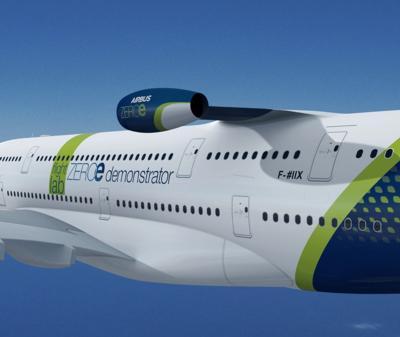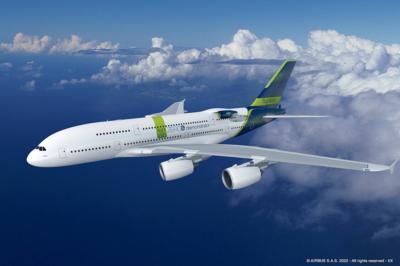Thu, Feb 24, 2022
A380 Testbed Will Analyze Efficiency, Engine Emissions in Flight
CFM and Airbus have announced a joint demonstration aircraft aimed at testing next-generation hydrogen tech.

Using the element as the basis for a sustainable fuel system has long been a goal in the industry, but until recent breakthroughs in storage and processing were made, it remained little more than a futuristic curiosity. Now, with investor interest higher than ever in sustainable, green fuels and the industrial backbone to create necessary liquid hydrogen in the works, the time is right for CFM to work with Airbus and complete a direct combustion engine. Should development proceed smoothly, the firms expect an entry into commercial service by 2035.
In order to run on the unorthodox fuel, the GE PassportTM turbofan will require modification to the combustor, fuel system, and control system. The engine was selected for its physical size, advanced turbo layout, and impressive fuel flow capability, being small enough to be mounted along the rear fuselage of the flying testbed to allow engine emissions to be monitored separately from those powering the aircraft up front. Of course, CFM affirms that it will complete ground testing long before ever placing an active engine into the air.

In partnering with Airbus, their program will use an A380 flight testbed equipped with specially designed and installed liquid hydrogen tanks built at the France and Germany factories. Airbus will define the hydrogen propulsion system requirements, oversee flight testing, and provide the A380 platform required in order to test the hydrogen combustion engine in cruise phase, with CFM handling the technical, design, and developmental side of the project.
“This is the most significant step undertaken at Airbus to usher in a new era of hydrogen-powered flight since the unveiling of our ZEROe concepts back in September 2020,” said Sabine Klauke, Airbus chief technical officer. “By leveraging the expertise of American and European engine manufacturers to make progress on hydrogen combustion technology, this international partnership sends a clear message that our industry is committed to making zero-emission flight.”
More News
Airplane Bounced About 3 Ft Then Touched Back Down And Then, With No Brakes Applied, The Airplane Began Veering To The Left Analysis: The pilot entered the airport traffic pattern >[...]
Aero Linx: British Microlight Aircraft Association (BMAA) The primary focus within all aviation activity is SAFETY. In all aspects of our sport SAFETY must come first, whether it b>[...]
From SnF25 (YouTube Edition): William Wynne Builds Practical Aircraft Engines on the Corvair Platform Seeking an affordable alternative to the traditional aircraft engine options, >[...]
How To Get A Story On Aero-TV News/Feature Programming How do I submit a story idea or lead to Aero-TV? If you would like to submit a story idea or lead, please contact Jim Campbel>[...]
From 2023 (YouTube Edition): Bridge of CiES CiES Inc. is a Bend, Oregon-based designer and manufacturer of modular embedded aircraft systems and sensors. The company’s fuel-l>[...]
 NTSB Final Report: Aviat A1
NTSB Final Report: Aviat A1 ANN's Daily Aero-Linx (07.08.25)
ANN's Daily Aero-Linx (07.08.25) Classic Aero-TV: Fly Corvairs Reliable Engine Alternative
Classic Aero-TV: Fly Corvairs Reliable Engine Alternative ANN FAQ: Contributing To Aero-TV
ANN FAQ: Contributing To Aero-TV Classic Aero-TV: CiES Fuel-Quantity and e-Throttle Systems Praised
Classic Aero-TV: CiES Fuel-Quantity and e-Throttle Systems Praised




